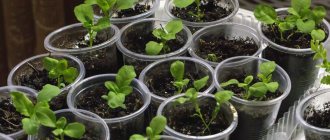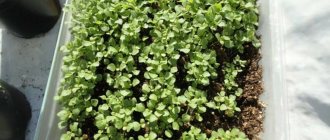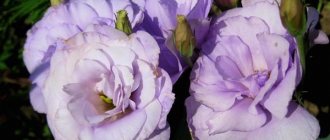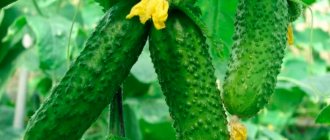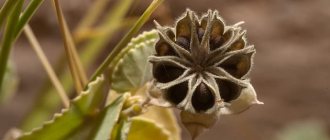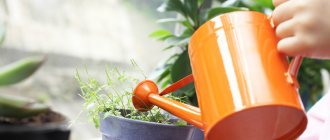Appearance
Eustoma has a strong and graceful stem, branching from the middle into a peduncle. The latter throws out up to 40 buds. The leaves of the plant are oblong, dense, and have a grayish-gray color. The height of the bush can be up to one meter. The opened buds transform into large flowers resembling roses, and when fully open they become like poppies. This was noticed by the people and eustomas were instantly nicknamed the Irish rose.
Eustoma buds resemble roses
Sometimes the plant is called “prairie bell”, due to its virgin habitats. Its homeland is considered to be:
1. Mexico.
2. States of Nebraska, Colorado, Texas.
3. Northern regions of South America.
The natural color of the petals is purple, but today, the natural version is not so easy to find. Thanks to the efforts of breeders, colorful hybrids grow in gardens. The flowering period occurs in the summer months and autumn.
Eustoma purple
Subtleties of breeding
Reproduction
Propagating a plant is not so easy. The problem is that this is not realized by dividing the bush. Adult individuals are not ready to recover from the destruction of the root system, which is an indispensable companion to the division process. The resulting divisions will also not be accepted. The cuttings also do not take root, so seeds remain the only available method of propagation for eustoma.
The optimal method of propagating eustoma is by seeds
They say that raising lisianthus seedlings from seeds is difficult, however, this is not entirely true. If you maintain optimal conditions for the seedlings in the first two months, then everything will go without incident.
When to sow?
Flower growers often sow seeds in December-January, but if you want to admire the aesthetic flowers longer, then this period should be expanded and the first batch of seeds should be placed in the ground in November. The final sowing month will be February. It makes no sense to sow eustoma later, in the spring. It simply does not have time to bloom, dying under the first snow. The secret is that the release of buds occurs at 15-20 weeks of growth, so consider whether the plant in your climate will have time to live a full cycle?
Nuances of the sowing process
It is recommended to sow seeds in disposable cups filled with a moistened soil mixture consisting of:
1. Peat soil.
2. Perlite.
3. Sand.
In this case, the soil will be looser and more breathable. If you don’t want to bother with preparing the soil, then you can purchase ready-made substrates designed for growing Saintpaulias.
Eustoma seedlings in disposable containers
Sow seeds superficially, without significant deepening. They just need to be lightly pressed into the soil. 3-5 seeds are placed in each container (calculated for picking). The seeded cups are covered with polyethylene to create a greenhouse effect and left alone until the seedlings germinate.
Just press the seeds a little into the soil
You can try another planting method, for which you will need peat tablets. Each of the tablets is soaked in water in turn. The seed is placed in the hole made, without further pressing down or sprinkling with earth. The “charged” tablet is sent into a disposable cup, which is covered with a lid. In order to ensure air access, the lid will have to be lifted periodically. With this method of germination, plants tolerate transplantation more easily and do not get sick, because root injury is completely prevented.
Planting eustoma seeds in a peat tablet
How to create comfortable conditions for seedlings
“In the first months of growth, eustoma needs bright but diffuse lighting, then the seedlings will germinate compactly and will not be too elongated”
In order for the seedlings to be strong enough, the seeds must initially be provided with good conditions for development. Lighting and temperature conditions will play an important role in this matter. In the first months of growth, eustoma needs bright but diffuse lighting, then the seedlings will germinate compactly and will not be too elongated. Fluorescent lamps can provide a similar light flow. By the end of winter, the seedlings can be moved to the sunniest windowsill. Under the rays of even a very weak sun, the seedlings will sharply increase in growth.
Eustoma seedlings need bright, diffused light
Ideally, you need to arrange a rack for growing eustoma seedlings, but if there is no space in the house for one, then you can get by with an ordinary shelf.
Racks for eustoma seedlings
The lower temperature limit of development for seeds is 20°, the maximum is 25°. Provided that the thermal regime is observed, the first shoots will appear on the 10-15th day. Do not be discouraged if in the first two to three months the growth of eustoma is practically unnoticeable. That's how it should be.
Seedling health
To prevent the seedlings from getting sick and to become strong, they can be watered with foundationazole in the first two months. The solution is prepared before use. A teaspoon of the substance is dissolved in a liter of water. To improve the development of plants, it is worth spraying them once with zircon or epin.
Zircon and epin for seedling growth
After this treatment, the seedlings actively begin to grow. In addition to the stimulating effect, the drugs have a protective effect and prevent the development of blackleg.
Picking process
If a month and a half has passed since the seedlings emerged, then it’s time to start picking. Planting into individual pots is a painstaking task and requires extreme caution. The jewelery of the work is the key to the rapid growth of lisianthus in the future. A thin awl will be a good assistant in extracting tiny bushes from the soil.
Picking eustoma seedlings
The hole in the new pot is made using a pencil. The seedling is inserted into the recess right up to the leaves. After replanting, lightly press the soil and also lightly moisten it. The process ends with the creation of a greenhouse effect. You can put a regular bag on the pot or cover the seedling with an inverted plastic cup.
Description of the flower
Eustoma has several other popular names that you might have heard: Japanese or Irish rose, Texas bell, lisianthus. The plant belongs to the gentian family; its homeland is considered to be the countries of Central America and the Caribbean islands.
This is interesting! Residents of this region tell a beautiful legend about the appearance of eustoma: it first bloomed in the place where an innocent girl was buried, who refused to become the wife of the Spirit of War, which is why he killed her in anger.
In Europe, eustoma became popular thanks to the Irish botanist Peter Brown. The plant immediately fell in love with flower growers due to the fact that its flowers, when cut and placed in a vase with water, remain fresh for up to three weeks. And already at the end of the 20th century, the plant began to be cultivated as an indoor plant.
There can be up to 35 buds on one eustoma stem
Lisianthus has strong and at the same time graceful stems about 1 meter high, which begin to branch from the middle of the length. Thus, one branch can be a whole bouquet, strewn with a large number of buds (up to 35 pieces), opening gradually one after another.
The leaves of the plant are lanceolate-oval, bluish or gray in color. Flowers with funnel-shaped deep cups up to 8 cm in diameter can be of any color, uniform in color or with a contrasting border. Closed or half-open buds resemble roses; a fully open flower resembles a double poppy.
Buy seeds from specialized stores: they are well prepared for growing
It is best to grow lisianthus at home from seeds. This is the simplest and most effective method, unlike cuttings. The seeds retain all species and varietal characteristics, which almost completely eliminates mutation. In addition, experts recommend giving preference to annual rather than biennial species. Below we will look in detail at several varieties that are ideal for growing from seeds at home.
The most common varieties of eustoma
We recommend that you buy seeds marked F1 on the package. This is how hybrids specially bred for cultivation in our climate are labeled. They are less capricious in terms of daylight hours and temperature conditions, have better germination and greater stability.
- Hybrid varieties of non-double forms of the Kyoto series with large flowers, a wide variety of shapes and colors. For its rapid growth and early flowering, flower growers fell in love with the White Kyoto variety.
- The velvet varieties from the Picot series deserve no less attention: Picot Blue, Picot Pink and Wine Red Picot. These flowers have a tall stem with large fragrant inflorescences of rich, bright red colors.
- The Mermaid series of hybrid varieties is distinguished by a wide range of colors in purple, lilac and pink tones. The Twinkie variety produces mostly soft yellow or snow-white flowers, sometimes with pink or purple splashes. Both varieties are non-double.
- Among the terry varieties one can distinguish such as Cinderella, Echo and Champagne. The first grade is distinguished by a variety of colors, the second and third - by monotony.
- Eustoma of the Sapphire variety is low-growing, with a peduncle no more than 15 cm. It is distinguished by white flowers with a pink or blue border at the edges of the petals.
Plant varieties (photo)
Eustoma White Kyoto is characterized by fast growth and early flowering
Eustoma Pink Picot has a tall stem
A distinctive feature of the Sapphire variety is a pink or blue border on a white petal.
The eustoma variety Cinderella has a particularly rich color
Twinkie variety eustoma can be white or yellow.
Landing in the ground
The best period for transplanting seedlings into the ground is considered to be the beginning of July. By this time, seedlings and seedlings will have time to form developed shoots and strengthen the root system, so they will take root without problems. Upon completion of the adaptation process, the plant will almost immediately throw out its flower stalks. The flowering period will last until frost.
Planting eustoma in open ground
In principle, eustoma is ready for planting in a flowerbed after the formation of the first 4-8 full leaves. Having felt the open ground, the bush begins to grow actively and after a couple of weeks the seedlings will be unrecognizable.
Planting of seedlings should be done in the evening. Remove each specimen along with the soil and lower it into a previously prepared, well-watered hole. Fill the remaining space with soil. Don't try to bury the roots. Leave them at the same depth as they were in the glass.
Transplant into prepared hole
Cover the transplanted bushes with a piece of plastic bottle. The shelter will protect the weak growth at first. In two weeks the “sarcophagus” can be removed.
Where to plant and in what soil?
The flowering plant prefers sunny places, or at least partial shade. Only there can it reveal itself in all its stunning beauty.
Eustoma prefers sunny places
As for the quality of the soil, it must be perfectly drained, with the correct acidity level. pH values are 6.5 – 7.0. An increase in acidity level will cause a slowdown in plant growth. Eustoma grows well on black soil.
Watering
Having migrated to the garden, eustoma will have to endure both drought and heat. The plant will cope with the task, although, of course, such conditions will not give it beauty. So think about regular watering. The soil should be moistened, but under no circumstances overwatered, so the next watering should be carried out no earlier than the top layer of soil has dried out.
Eustoma needs regular watering
When watering eustoma, you need to try not to get it on the leaves. Pour water directly under the root. This way you will protect your flowers from being damaged by fungal diseases. For the same reason, plants are not irrigated with a spray bottle.
Seeds: collect or buy?
This plant pollinates well, so after a while, boxes full of small seeds will appear on it. The latter give good germination. If you are breeding a hybrid type of eustoma, then they can be collected and used for propagation. The next generation will be similar in almost every way to the parent bushes, but the seeds that appear on them will give rise to seedlings with already quite strong distinctive features.
Box with eustoma seeds
As summer residents say: the eustoma will degenerate, and you will not get a tinted flower. As you can see, if you do not have seeds from first-year bushes, then it is better to purchase varietal seed packages in the store.
Diseases and pests
Like any seedlings, eustoma sprouts can be affected by such a well-known fungal disease as “black leg”. When part of the stem of a young sprout turns black and becomes weak, there is only one way out - to remove it urgently. Then, in order to save other seedlings from infection, you should replace the soil as much as possible and treat it with Previcura solution. Since it is impossible to cure a plant from this disease, prevention is very important here: disinfection of the soil before sowing, timely removal of condensate and compliance with the watering regime.
In adult plants, dense planting and improper watering, as well as low temperatures, cause diseases of powdery mildew, fusarium wilt and gray mold. To combat them, various fungicidal drugs are used. Proper care and preventative measures are very important here.
If whiteflies, aphids, fungus gnats or leaf miners appear on the seedlings, you can treat the crop with an insecticide. Metaldehyde will help protect plants from slugs.
How to preserve eustoma in winter
“Before taking lisianthus from the garden, you should treat the bush with preventive agents to rid it of pathogenic spores and pest larvae”
We have already mentioned that eustoma in our area is grown as an annual, however, if desired, you can try to preserve adult bushes for the next season. To do this, you will have to dig them up and, transferring them to pots, take them home for the winter. Some gardeners initially use a trick, planting the plant directly in pots, then in the fall they get plants ready for wintering. All that remains is to remove the buried pots from the ground.
Eustoma in pots
The process of adaptation to indoor conditions, after living in the open ground, sometimes does not proceed smoothly. The period of acclimatization to new conditions may take up to a month. Plants have a hard time tolerating the change from outdoor coolness to home warmth and low light. They may weaken somewhat and even begin to wither. This is a reason to start moving the eustoma out of the garden early, around the end of August. At this time, the street and room temperatures are almost identical.
A short stay on a closed loggia can help the plant get used to the lack of light. In parallel with these actions, watering is limited. This measure is necessary, because during the adaptation period the bushes will not be able to absorb the same volumes of water.
In winter, light from the window will save eukoma from light deficiency
Sometimes you can find recommendations for pruning eustoma before planting in a pot, and it is recommended to do this almost to the root. After the procedure, the plant often throws out root shoots.
Before taking lisianthus from the garden, you should treat the bush with preventative agents to rid it of pathogenic spores and pest larvae. It should not cause disease in indoor plants.
Eustoma is a real decoration of the garden
No matter how well you take care of your eustoma, after five years you will still have to part with it, because with the change of generation it will begin to produce fewer and fewer flowers, and their sizes will become smaller and smaller. Sometimes the plant dies on its own, for no apparent reason. You need to approach this moment philosophically and not reproach yourself for the lack of attention to your beloved child.
Helpful hints
- If the seeds do not germinate for a long time, you can pierce the granule, thereby facilitating the “pipping” of the sprouts.
- At first, some gardeners recommend using cold boiled water to safely water small sprouts.
- When feeding eustomas, keep in mind that when growing green mass, the plant requires more organic matter and nitrogen, and when forming flower buds, potassium and phosphorus.
- To make the eustoma bush more magnificent and dense, you can pinch the seedlings. However, please note that this may delay flowering for another 2 weeks.
- You should not plant eustoma near iron or brick walls and fences, as when they get very hot under the sun, they can cause burns to the delicate plant.
Growing eustoma from seeds is, of course, a very long and quite labor-intensive process. But many fans of this plant, having gradually gained experience, now do it relatively easily and successfully. If the overseas beauty eustoma has captured your heart, do not be afraid and be sure to try growing it yourself. And when it blooms in your garden, you will receive incomparable joy.
